
Case Hardened Firearm
Case hardening is a precise surface treatment process. It comes in various types, including induction hardening, carbonitriding, and nitriding, among others. You can apply it to increase surface hardness. The technique primarily enriches the outer layer of your component. It typically uses carbon or nitrogen diffusion at high temperatures, ranging from 500°C to 580°C. This occurs through a process known as carburization. The surface becomes extremely hard and wear-resistant.
Meanwhile, your part’s inner core stays soft. That keeps it rigid and shock-resistant inside. You get components that handle stress well.
Case-hardened parts are perfect for high-friction, high-impact conditions. Moreover, it extends the life of your parts. It also improves performance in demanding environments. In this article, you’ll explore the whole process. You’ll also see real-world uses and advantages.
What is Case Hardening?
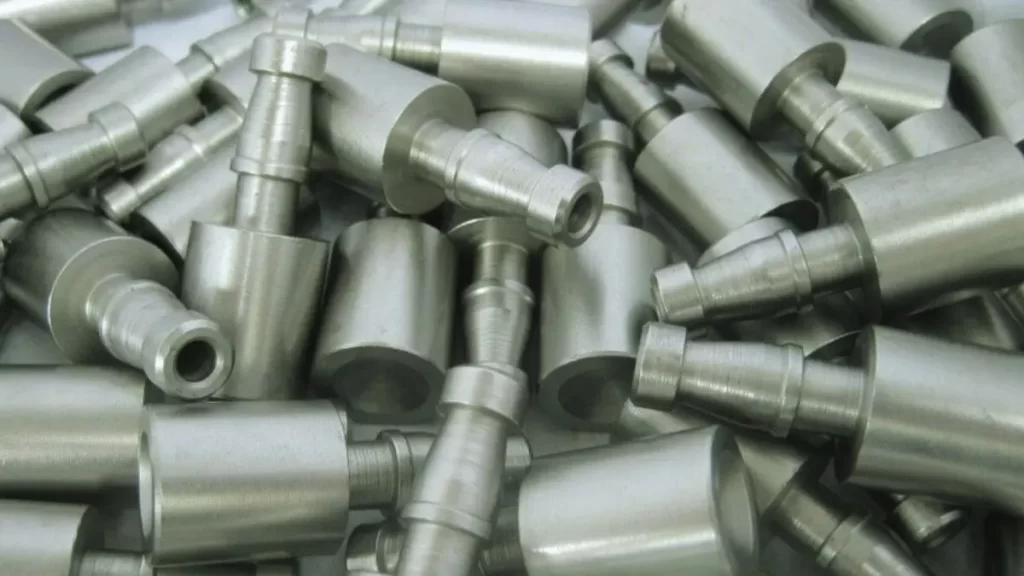
Case Hardening
Case hardening is similar to the surface treatments process. It is usually used to harden metal surfaces. The inner core remains both tough and resilient. This gives your parts combined characteristics.
A soft core handles impacts and stress better. It stays ductile, strong, and shock-resistant. But on its own, it wears down quickly. That’s why you need surface-level hardness, too.
That’s where Case hardening steps in. It helps you fight wear and friction. Further, it keeps parts from eroding during operation. You get better durability without losing toughness.
You can harden surfaces in different ways. Sometimes you can change the crystal structure directly. Other times, you can add new elements to the surface. However, heat is always imperative, regardless of the method.
High temperatures facilitate diffusion and chemical changes. That’s how you form a thin, hardened layer. Overall, it gives your part the perfect surface performance. (Read about precipitate hardening).
Case Hardening Process
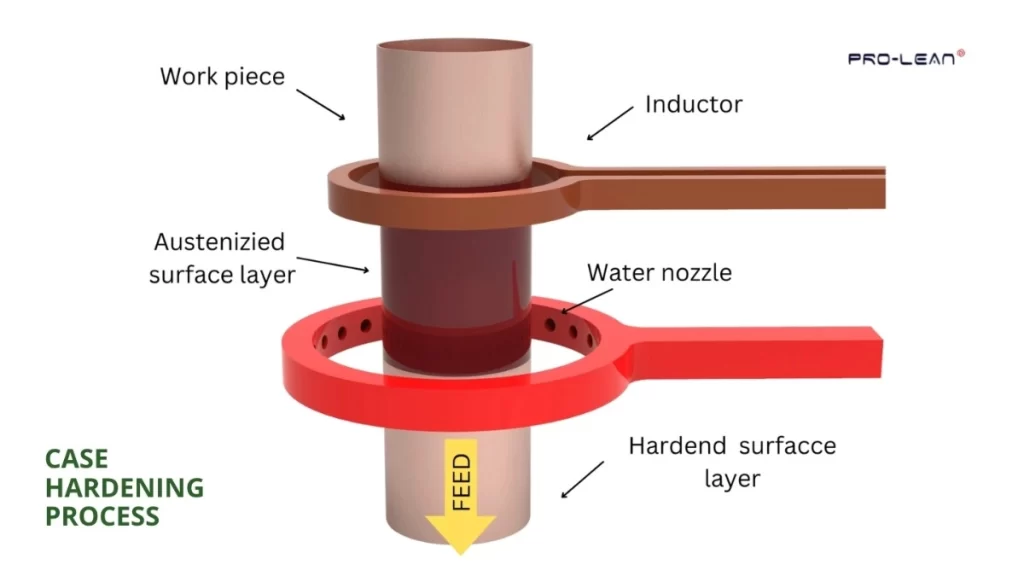
Case Hardening Process
Let’s see how to case harden steel or other metals. The procedure involves carburizing, followed by hardening, before tempering takes place. It transforms the material composition and its resistance properties. The complete case hardened process executes as follows.
Carburizing: It Adds Carbon to the Surface
Metal Carburizing Process
The initial procedure involves carburizing. During this process, the part is heated within a carbon-rich environment. The temperature stays between 880°C and 950°C. The metal surface becomes permeable to carbon during the heating process. After the process, you will get a hard layer enriched with carbon on your surface. Toughness remains intact because the interior section of the metal stays soft.
The two commonly used carburizing processes include gas treatment and salt bath treatment. When performing gas carburizing, you surround the part with carbon gases to achieve the process. Salt bath carburizing involves placing the component inside a molten salt bath. The carbon particles penetrate the material surface through both treatment processes. An extra-resistant layer forms as a result of the process. Heating time determines the depth of carbon infiltration.
Hardening: Locking in the Strength
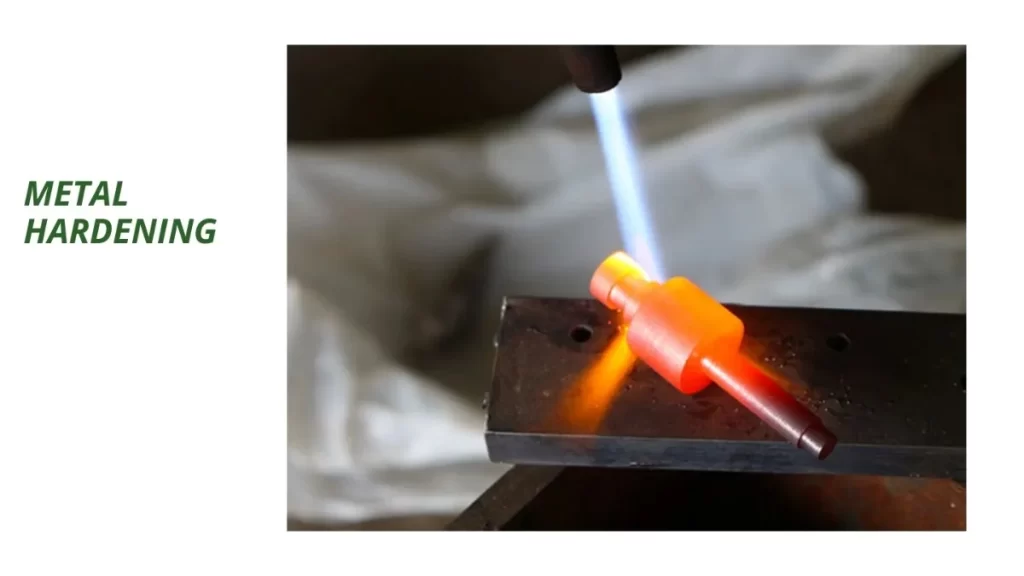
Metal Hardening
After finishing carburization, the parts are then subjected to hardening. The part requires reheating until it reaches the austenitizing range. The surface obtains readiness from structural change before proceeding. The object receives rapid quenching through the use of oil, water, or air applications. Fast cooling traps the complex martensitic structure within the material.
The surface strength of your part rises through a hardening process. The surface strength gains from hardening simultaneously improve resistance to fatigue and load-bearing capacity. Your part can be quenched immediately after carburization or after the reheating process is complete. The purpose of this process is to generate a strong external covering.
Tempering: Improves Toughness and Reduces Stress
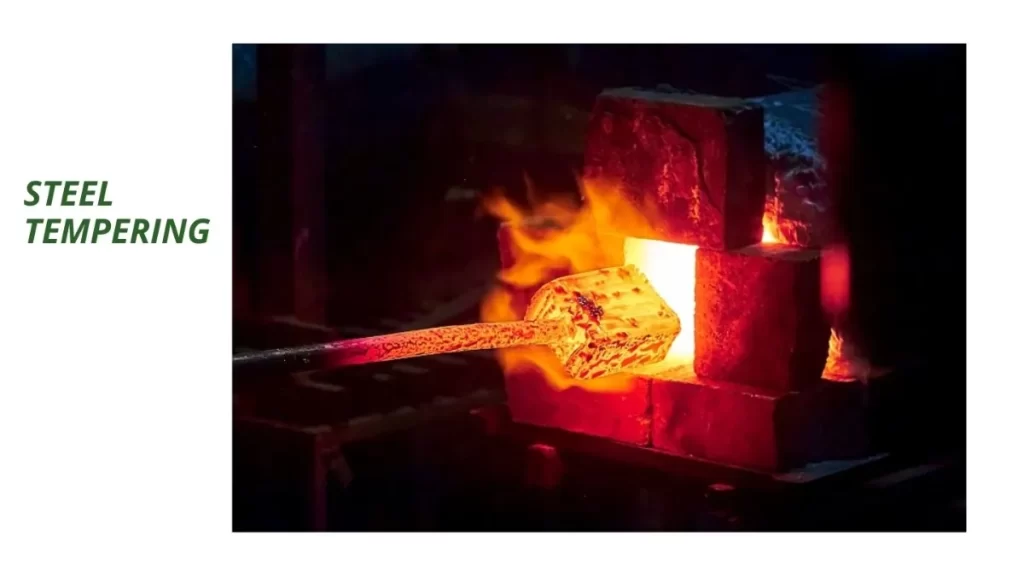
Steel Tempering
The last heat treatment process is known as tempering. After hardening, the part receives another heating process at reduced temperatures. Slowing down the cooling procedure is essential to achieve the desired results. During tempering, the Internal stress and brittleness decrease.
A surface that easily crumbles should be avoided at all costs. The tempering process allows you to balance strength by increasing the material’s ductility. The final mechanical properties receive their optimal state through this method.
When To Use Case Hardening?
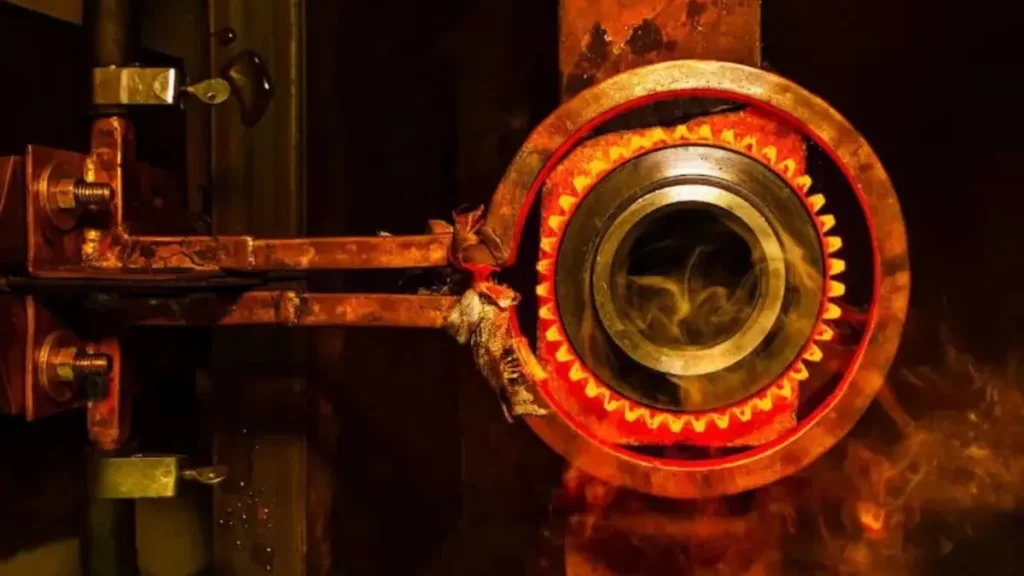
Applications of Case Hardening
The application of case hardening occurs when retaining surface durability is a priority. It is ideally suited for soft metals, including mild steel, and rarely to some non-ferrous metals using specialized processes. The materials require external assistance to combat wear damage. You should wait until the surface hardens, as machine tools find it more challenging to work with hard surfaces.
Some processes require hardening to take place before the manufacturing stage. The method depends on your product design, as well as its functional needs. The primary purpose remains the same throughout all procedures. The surface must have excellent durability while maintaining internal flexibility.
When Budget Is a Major Concern
The high price tag accompanies tool steels because these provide improved strength properties. In some cases, they can cost over 20 times more than basic materials. You don’t always need tool steel strength. The alternative material for this application would be low-carbon steel. It enables you to achieve better cost reduction through both material and energy efficiency. Heating the entire cross-section of material is not necessary. The critical areas become tough while the rest of the material remains unaffected.
When You Need Special Properties
Case hardening provides equipment owners with distinctive properties. The external surface presents a protective layer of hardness. On the other side, the inner material remains supple. The material inside the core section can take in stresses and impacts. The exterior surface maintains its ability to resist friction and handle wear.
The combined properties of a hard exterior and a soft interior make couplings perform better. Such components extend their operational lifespan because they manage misalignment more effectively. Hardened parts made this way do not provide the same range of movement. Case hardening gives your component the necessary strength and dependability. (Read more: machinability of materials)
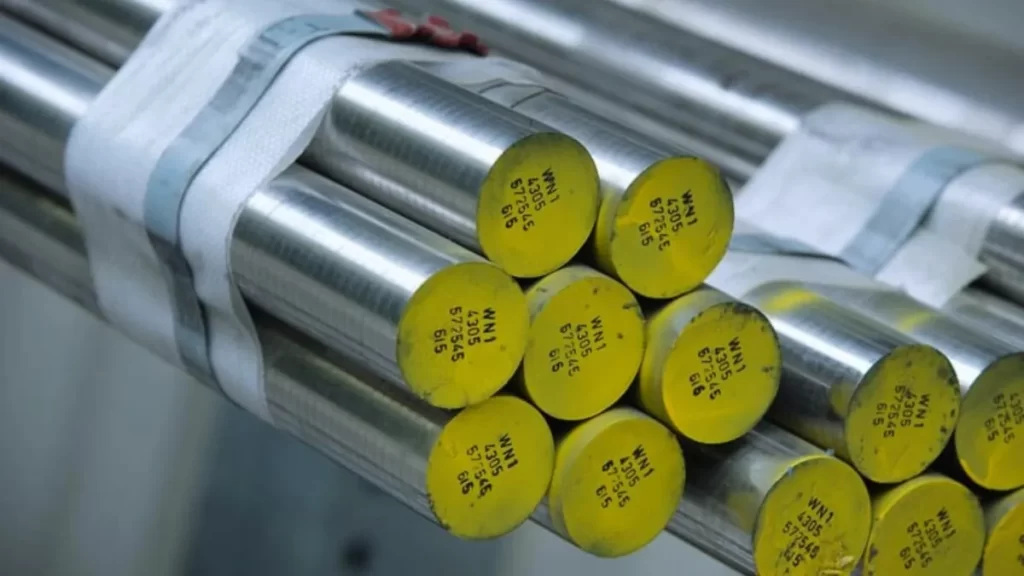
Steel Grading
The acquisition of tool steel is sometimes impossible. The present grade may not exist within your local stock points. Additionally, the required product dimensions may not be available in the market.
The purchase of large stock dimensions results in both monetary loss and delayed production time. You can choose low-carbon steel since it has better availability than high-grade steel products.
You can apply the hardening process only to the selected surface areas. The technique yields satisfactory results for non-essential applications. You effectively handle supply matters and maintain standard operational capabilities.
When the Application Demands Surface Strength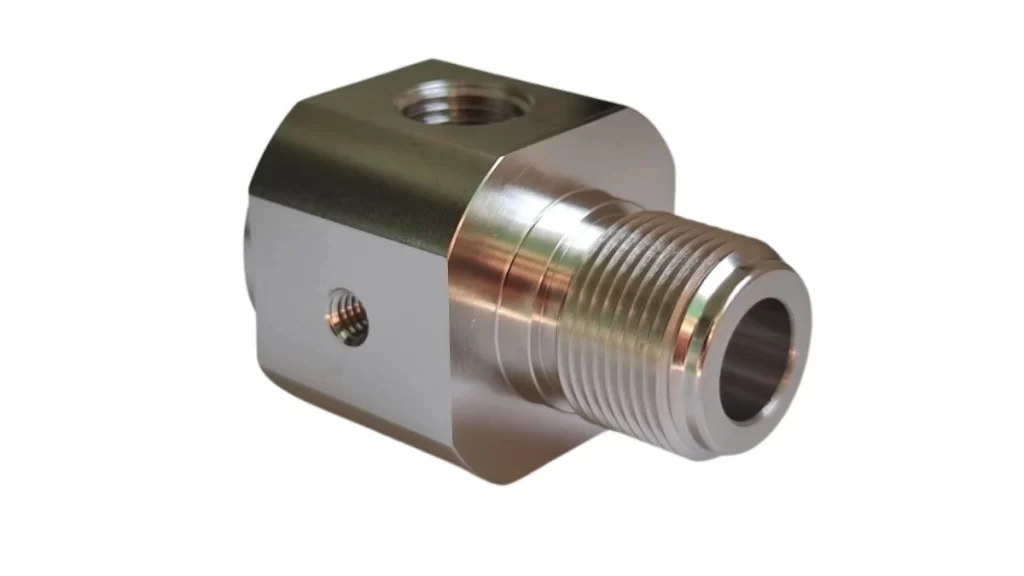
Durable Case Hardened Steel Component
Not all parts need to be hard throughout. Some only need protection on the outer surface. This is common in parts like files and gear teeth.
Files need hardness from their teeth alone, while the rest of the material remains unhardened. The material should be hardened only through its surface layers. The product maintains adequate durability even after achieving the desired surface hardness. The rigid core remains easy to manufacture along with the hardened surface.
Understand the operation of gears when they encounter mechanical stress. The teeth need to be hard to last longer and resist wear and tear. Despite this requirement, their entire interior does not require complete hardness. Making the gear material too hard throughout will create brittleness. The case hardening process solves this problem entirely. Through these processes, you achieve resistance to wear while maintaining flexibility throughout the core material.
What Types of Metals Can Be Case Hardened?
- Low Carbon Steel
- High Carbon Steel
- Cast Iron
- High Strength Low Alloy Steel (HSLA)
Tool Steel - Stainless Steels
- Titanium and Aluminum Alloys (Special Cases)
Common Components You Can Case Harden
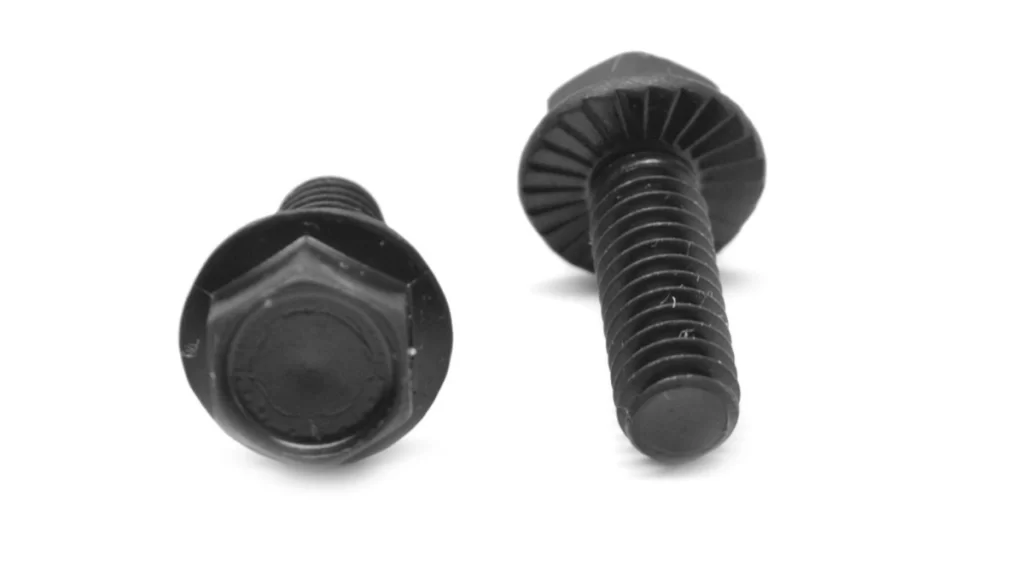
Case Hardened Fasteners
- Gears
- Fasteners
- Camshafts
- Rods
- Pins
- Crankshafts
- Axles
- Bearings
- Couplings
- Shafts
- Springs
- Gear teeth
- Valve seats
- Clutch plates
- Pulleys
Case Hardening Vs. Surface Hardening
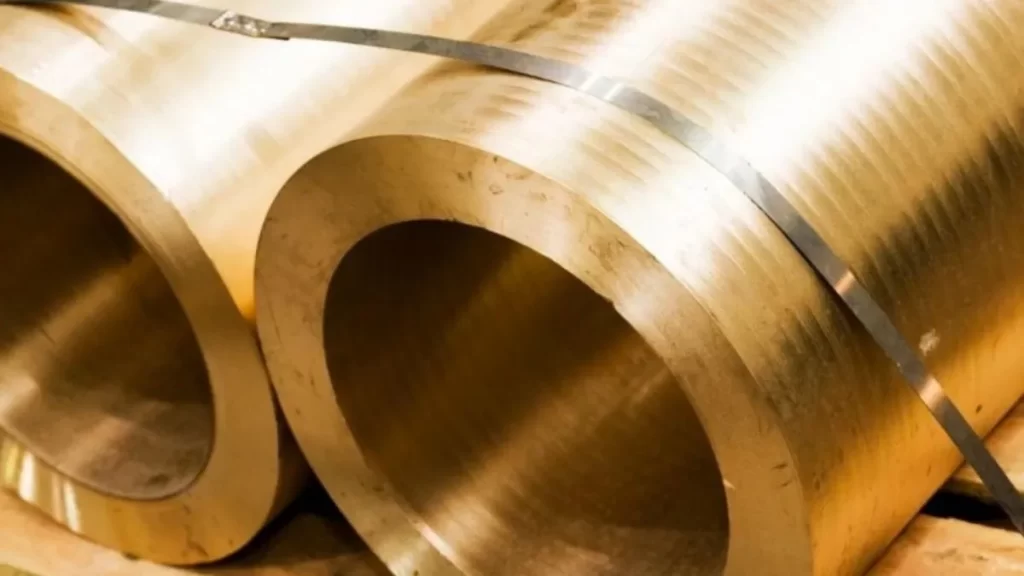
Surface Hardening
Surface hardening produces hardening effects that solely affect the external surface area of the part. You heat the surface to a set temperature while keeping the inside below the austenitizing point. You should quench the heated material at the desired surface temperature into a medium composed of water, oil, or air. The rapid heating causes the outer layers to harden. It leaves the inner area of the material in its original state.
On the other hand, in case hardening, carbon or nitrogen is introduced at the surface, and heat is applied to allow it to diffuse into the metal. The external part becomes hard, despite the internal core remaining in its flexible state. The process requires chemical diffusion, high temperatures, and prolonged exposure to these conditions.
What Is Case Hardened Steel?
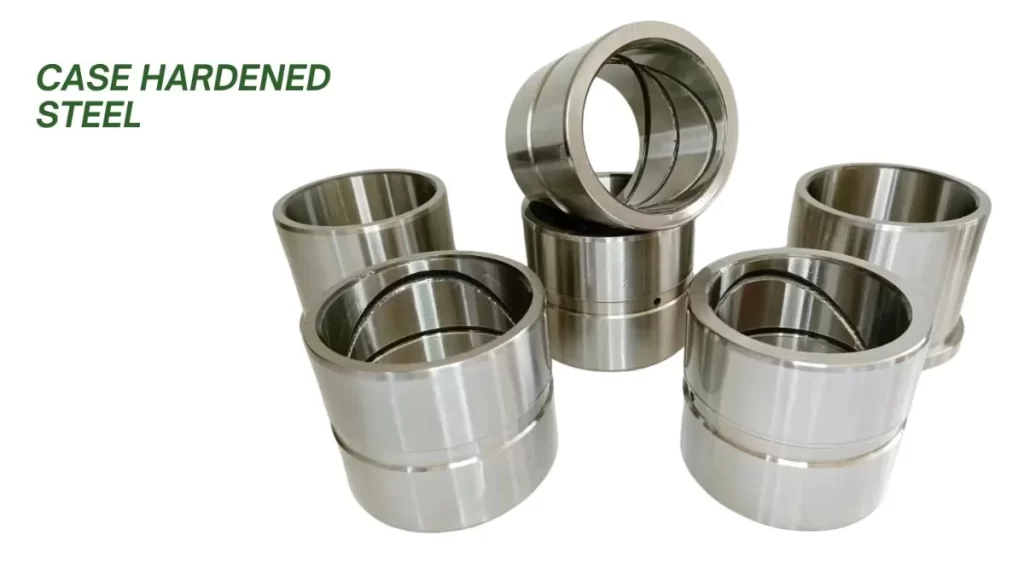
Case Hardened Steel Parts
Case hardened steel encompasses a hard outer layer. In operation, you treat steel parts with heat to improve surface strength. The core of steel remains soft, yet rigid and flexible. This mix helps the part resist wear and impact.
You’ll find it in components such as gears and fasteners. It works great where friction and stress happen often. You use it in cars, machines, and heavy tools. The surface stays strong, while the inside absorbs shock.
Benefits of Case Hardening
Here are the standard benefits of heat treatment of metals, such as case hardening.
Longer Lasting Parts
Through case hardening, a product achieves an extended operational lifespan. The protective outer layer of the parts provides durability by resisting mechanical stress. So, it prolongs their service life. Usually, it works best for components that experience continuous pressure or motion.
Better Wear Resistance
The outer layer becomes tougher because it resists damage from scratches, dents, and various other types of impacts. The ability of case-hardened parts to withstand intense usage leads to improved durability, as they do not break down as rapidly. So, it results in a reduced need for replacements and maintenance.
Stronger and More Reliable
The process makes parts stronger. Strong forces do not cause such components to flex or fracture. It strengthens components that experience high mechanical stress, particularly in gears and shafts.
Withstands High Heat
The strength of case-hardened parts remains intact even when they are subjected to high operating temperatures. These components are excellent choices for hot operating environments due to their heat tolerance.
Summary
Case-hardening is a valuable surface treatment. Its use is widespread in various industries today. Particularly, it’s effective in situations where vibrations, shock loads, and misalignment are common. It provides the ideal combination of surface hardness and durability, without rendering the material overly brittle.
At Prolean Tech, we offer comprehensive metal heat treatment services for your custom parts. You can choose from carburizing, induction hardening, nitriding, or carbonitriding. We adjust the process to match your metal type and design requirements. Whether you’re using low-carbon steel, alloy steel, or special materials, we make sure the surface gets strong while the core stays tough. You will receive parts with better wear resistance, longer part life, and optimal performance. We work on complicated parts like gears, shafts, pins, fasteners, and more.
We hope this guide has helped you gain a better understanding of the case hardening process. For more insights on heat treatment methods and other mechanical engineering topics, explore our blog and stay updated.
FAQs
Q1: What is meant by case hardening?
Case hardening is a heat treatment process. It hardens only the outer surface of metal parts. The core remains soft and resilient on the inside. This boosts both wear resistance and strength.
Q2: What are the disadvantages of case hardening?
Case hardening can’t penetrate deep into thick parts. It’s also time-consuming and energy-intensive. Some methods require special equipment or gases. Not all metals can be case hardened.
Q3: What is the color of case hardening?
Case-hardened steel shows blue, brown, or purple shades. These colors originate from oxidation during the heat treatment process. It gives a distinct, patterned surface look. The exact tone depends on temperature and method.
Q4: Why is the crankshaft case-hardened?
Crankshafts face heavy loads and friction. Case hardening increases their surface strength and durability. It prevents wear without making the core brittle. That way, it lasts longer under stress.
Q5: What is an example of a case hardening?
Carburizing is a typical case hardening process. It adds carbon to the surface of low-carbon steel. Gears, camshafts, and pins often use this method. These parts need a hard shell with a rigid core.
Q6: What is the difference between surface hardening and case hardening?
Case hardening is a type of surface hardening. It hardens the outer layer of a metal. However, color case hardening often involves chemical changes, such as the infusion of carbon or nitrogen. Surface hardening can also be achieved through direct heating or the use of lasers.




After study a handful of the blogs in your website now, and i really much like your means of blogging. I bookmarked it to my bookmark site list and you will be checking back soon.
Thanks zackary ! Surly check our blogs
Its like you learn my thoughts! You seem to understand so much approximately this, such as you wrote the e-book in it or something. I believe that you could do with some to power the message home a bit, but other than that, that is fantastic blog. A fantastic read. I’ll certainly be back.
Thanks, I have recently been seeking for details about this topic for ages and yours is the best I’ve found so far.
I is great that our blog was helpful for you! Thanks
Heya just wanted to give you a brief heads up and let you know a few of the pictures aren’t loading properly. I’m not sure why but I think its a linking issue. I’ve tried it in two different web browsers and both show the same results.
Thanks for feedback! I will check on back-end to solve the issue !
Isn’t it entertaining if we always talk about topics like that.’~~;~
We are trying to make blogs that are informative as well entertaining for Manufacturing professionals!
This design is spectacular! You definitely know how to keep a reader entertained. Between your wit and your videos, I was almost moved to start my own blog (well, almost…HaHa!) Fantastic job. I really enjoyed what you had to say, and more than that, how you presented it. Too cool!
Thanks Omar for your kind words! We regularly upload blogs on CNC, sheet metal, injection molding, and other area. Keep checking us.
Wow, fantastic blog format! How lengthy have you been running a blog for? you make running a blog glance easy. The overall glance of your website is great, let alone the content material!
Thank you! Deandra. We have been providing CNC Machining , sheet metal, and other related manufacturing services for more than a decades But, we are in e-manufacturing since last three years! Please let us know if you need any related services.
Good an very informative post. I will come back to your blog regullary.
Thanks Allen!
I’ve already been examinating away some of your tales and it is pretty excellent things. I’ll certainly bookmark your own blog.
Hey website owner, thank for sharing this valuable infos! It helped me a lot!
Thanks for all your efforts that you have put in this. very interesting info regarding the case hardening methods.
You can definitely see your skills in the work you write. The world hopes for even more passionate writers like you who aren’t afraid to say how they believe. Always go after your heart.
Thanks Elwanda!
Aw, i thought this was quite a nice post. In notion I would like to put in place writing such as this additionally – taking time and actual effort to generate a very good article… bu
Appreciating the time and energy on Case hardening, in depth information you provide. It’s great to come across such a technical focused article? How to solve the issue of cracks in induction hardening of steel, i am facing this issue a lot ! Do you provide induction hardening services?
I’ve been recently wondering about the exact same point myself lately. Glad to see a person on the same wavelength! Nice article.
I recognize there exists plenty of spam on this blog. Do you want support cleansing them up? I may help amongst courses!
nice blog and really nice post. i like it. make a fanpage on facebook.
I would like to show my thanks to this writer for rescuing me from such a instance. Because of looking throughout the world-wide-web and getting opinions which are not beneficial, I figured my life was well over. Living without the presence of solutions to the difficulties you have fixed as a result of your good short article is a critical case, and the kind which might have in a negative way damaged my entire career if I had not encountered your web site. Your good competence and kindness in maneuvering everything was important. I don’t know what I would’ve done if I had not encountered such a subject like this. I am able to now look ahead to my future. Thanks for your time so much for your reliable and amazing guide. I will not be reluctant to propose your blog post to any person who wants and needs guidance on this issue. [Reply]
aluminum curtains rods are much lighter than those steel rods that we previously used;;
I must admit that that is one amazing insight. It surely gives a company the opportunity to get in on the ground floor and also really take part in creating something special and tailored to their needs.
As I website owner I believe the content material here is very superb, thanks for your efforts.
thank you patric!
Heya i am for your first time here. I came across this board and I obtain It really beneficial & it aided me out considerably. I hope to give something again and help others like you assisted me.
thanks Gisele for your kind words!
Great weblog here! after reading, i decide to request a quote for my steel machining project!
Just want to to say this article is as astounding. The clarity of case hardening is just excellent and i could assume you are an expert on this subject.
Thanks for your words !
I am often to blogging on on demand and i actually appreciate your site content.
Thanks Charles!
Thanks Arron
very nice post, i certainly adore this web site, continue it